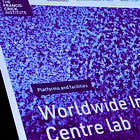NIH Funds Creation of New Influenza Viruses in China That Replicate Better, Trigger More Inflammation in Human Cells: 'Virology Journal'
Engineered using bird, dog, and human strains behind past pandemics, including 2009 H1N1—under NIH grant principal investigator serving as WHO director.
A newly published study confirms that the U.S. National Institutes of Health (NIH) funded researchers in China to create novel influenza viruses using strains that have already caused global pandemics—and the new lab-made viruses turned out to be more infectious and more inflammatory than their natural counterparts.
The mainstream media are not reporting these studies, so they must be discovered through independent research like this.
This website recently reported that NIH-funded researchers at the University of Tokyo and University of Wisconsin used reverse genetics to rebuild pandemic-capable H5N1 bird flu, deliberately engineering drug-resistant, mammal-adapted strains under lab pressure—despite claims that gain-of-function research has been halted.
Moreover, NIH-funded scientists at Washington University have used reverse genetics to build over 200 synthetic, barcoded SARS-CoV-2 viruses—each enhanced with the D614G mutation for increased transmissibility—despite global acknowledgment that similar research likely caused the COVID-19 pandemic.
Follow us on Instagram @realjonfleetwood & Twitter/X @JonMFleetwood.
If you value this reporting, consider upgrading to a paid subscription.
The current head of the NIH is Dr. Jayanta Bhattacharya, who became the 18th director of the agency on April 1, 2025, under U.S. Health and Human Services (HHS) Secretary Robert F. Kennedy.
The new study, published July 1 in Virology Journal, is titled “Viral characterization of the reassortants between canine influenza H3N2 and human pandemic (2009) H1N1 and avian H9N2 viruses in canine ex vivo tracheal explants.”
It was conducted at the University of Hong Kong and funded by the NIH under contract 75N93021C00016, alongside the Hong Kong government’s InnoHK program.
That NIH grant was awarded to St. Jude Children’s Research Hospital in Memphis, Tennessee, with Dr. Richard Webby as principal investigator and Dr. Stacey Schultz-Cherry as co-principal investigator, totaling $8.99 million.
Dr. Webby is Director of the World Health Organization (WHO) Collaborating Centre for Studies on the Ecology of Influenza in Animals and Birds.
The Bill & Melinda Gates Foundation is the largest private contributor to the WHO, providing about 10% of its total budget.
The study authors genetically engineered new flu viruses by combining:
Canine H3N2 influenza (an avian-origin virus circulating in dogs),
2009 pandemic H1N1 (the swine flu that infected over a billion people worldwide),
And avian H9N2, a strain that has seeded the internal genes of multiple deadly avian flu viruses infecting humans—including H5N1, H5N6, H7N9, and H10N8.
Built & Proven More Dangerous
In serial co-infection experiments using live canine airway tissue, scientists deliberately mixed pandemic-capable strains and cultured the resulting hybrids in human lung cells.
“All reassortants replicated with similar or greater efficiency as compared to the parental strains,” the researchers report.
Several of the newly created viruses triggered elevated levels of TNF-α, a proinflammatory cytokine linked to severe disease and immune system overreaction.
In other words, these engineered viruses:
Infect human cells more efficiently
Replicate at higher levels
Induce stronger immune responses, raising concerns about cytokine storms and acute respiratory distress
Why This Is Alarming
These experiments represent classic gain-of-function research.
They increased the transmissibility and virulence of pandemic viruses through artificial manipulation.
The NIH-backed team:
Used viruses already known to cause global pandemics
Enhanced their capabilities
And tested them directly in human lung cells
The study shows that dogs can serve as “mixing vessels,” purportedly combining bird and human viruses into dangerous hybrids.
That means a new pandemic virus could emerge from canine populations, and scientists are actively modeling that possibility in the lab with NIH money.
“H3N2-CIV readily reassorted with human H1N1pdm and avian H9N2… suggesting that these reassortants have a considerable zoonotic risk,” the study warns.
NIH Repeats What Likely Caused COVID Pandemic
The 2009 H1N1 virus used in this study was a pandemic virus.
The avian H9N2 virus used in this study has repeatedly donated genes to deadly human influenza viruses.
And the NIH has again funded the creation of more dangerous versions of both in a Chinese lab.
This is the same playbook that led to COVID-19:
U.S. money
Risky virus enhancement
Foreign biosafety jurisdiction
Pandemic-capable viruses
Congress, the White House, the Department of Energy, the FBI, and the CIA acknowledged that a lab-related incident involving gain-of-function research is most likely the origin of COVID-19, raising concerns that ongoing experiments like these could trigger another pandemic.
Follow us on Instagram @realjonfleetwood & Twitter/X @JonMFleetwood.
If you value this reporting, consider upgrading to a paid subscription.
For advertising & sponsorship opportunities reaching 230,000+ monthly viewers, contact us by clicking below.













Canine. So as to be able to prevent people from keeping dogs for their personal protection.
Those working at the NIH should be indicted for violating the the Biological Weapons Anti-Terrorism Act of 1989, the Patriot Act, The Bioterrorism Act of 2002, and Congress, the White House, DOE, and CIA should be indicted as accomplices. They should all be indicted for conspiracy. And the International Criminal Court should indict them for violating the Biological Weapons Convention. Now you know why the DA's offices never hired me!